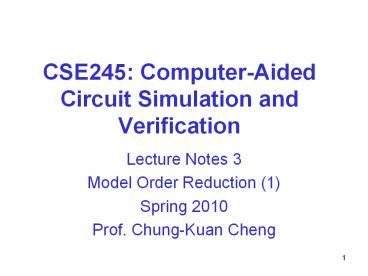CSE245: Computer-Aided Circuit Simulation and Verification - PowerPoint PPT Presentation
Title:
CSE245: Computer-Aided Circuit Simulation and Verification
Description:
Title: UCSD CSE245 SP06 Computer-Aided Verification of Electronic Circuits and Systems Author: Vincent H. Peng Last modified by: CK Created Date – PowerPoint PPT presentation
Number of Views:170
Avg rating:3.0/5.0
Title: CSE245: Computer-Aided Circuit Simulation and Verification
1
CSE245 Computer-Aided Circuit Simulation and
Verification
- Lecture Notes 3
- Model Order Reduction (1)
- Spring 2010
- Prof. Chung-Kuan Cheng
2
Outline
- Introduction
- Formulation
- Linear System
- Time Domain Analysis
- Frequency Domain Analysis
- Moments
- Stability and Passivity
- Model Order Reduction
3
Transfer Function
- State Equation in Frequency Domain ( suppose zero
initial condition)
- Recall
- U is 1xn vector of inputs (voltage, current
sources) - X is state variable (voltage or current of
inductor, cap., etc.) - Y is voltages of current sources currents of
voltage sources. - C is defined as
- A is defined as
- Will show that D BT
Solve X
Express Y(s) as a function of U(s)
Transfer Function
4
Stability
- A network is stable if, for all bounded inputs,
the output is bounded. - For a stable network, transfer function
H(s)N(s)/D(s) (general form) - (Recall H(s) Y(s)/U(s) in our case)
- Should have only negative poles pj, i.e. Re(pj) ?
0 - If pole falls on the imaginary axis, i.e. Re(pi)
0, it must be a simple pole.
5
Passivity
- Passivity
- Passive system doesnt generate energy
- A one-port network is said to be passive if the
total power dissipation is nonnegative for all
initial time t0, for all time tgtt0, and for all
possible input waveforms, that is, - where E(t0) is the energy stored at time t0
- Passivity of a multi-port network
- If all elements of the network are passive, the
network is passive
6
Passivity in Complex Space Representation
- For steady state response of a one-port
- The complex power delivered to this one-port is
- For a passive network, the average power
delivered to the network should be nonnegative
7
Linear Multi-Port Passivity
- For multi-port, suppose each port is either a
voltage source or a current source - For a voltage source port, the input is the
voltage and the output is a current - For a current source port, the input is the
current and the output is a voltage - Then we will have DBT in the state equation
- Let U(s) be the input vector of all ports, and
H(s) be the transfer function, thus the output
vector Y(s) H(s)U(s)
- Average power delivered to this multi-port
network is
- For a passive network, we should have
8
Linear System Passivity
- State Equation (s domain)
- We have shown that transfer function is
and
where
- We will show that this network is passive, that is
Why is this important? After Model Order
Reduction (MOR) (in later slides), this condition
must still be true.
Plug conjugate H(s) in here
9
Passivity Proof (part 1)
- To show
- Is equivalent to show
Heres how
where
Re U(s)H(s)U(s) 0 Set U(s)H(s)U(s)
F ½ Re(F F) 0 F F 0 Plugging F back
in (U(s)H(s)U(s)) U(s)H(s)U(s)
U(s)H(s)U(s) U(s)H(s)U(s) U(s) (H(s)
H(s)) U(s) 0
10
Passivity Proof (part 2)
- We have
- Thus
11
Passivity and Stability
- A passive network is stable.
- However, a stable network is not necessarily
passive. - All poles could be on LHS, but some could be
negative! - A interconnect network of stable components is
not necessarily stable. - The interconnection of passive components is
passive.
12
Model Order Reduction (MOR)
- MOR techniques are used to build a reduced order
model to approximate the original circuit
Huge Network
Formulation
Small Network
Realization
MOR
13
Model Order Reduction Overview
- Explicit Moment Matching
- AWE, Pade Approximation
- Implicit Moment Matching
- Krylov Subspace Methods
- PRIMA, SPRIM
- Gaussian Elimination
- TICER
- Y-Delta Transformation
14
Moments Review
- Transfer function
- Compare
- Moments
15
Moments Matching Pade Approximation
Choose the 2q rational function coefficients
So that the reduced rational function
matches the first 2q moments of the original
transfer function H(s).
16
Moments Matching Pade Approximation
- Step 1 calculate the first 2q moments of H(s)
- Step 2 calculate the 2q coeff. of the Pade
approximation, matching the first 2q moments of
H(s)
17
Pade Approximation Coefficients
For a1 a2,, aq solve the following linear system
Then, use the a1 a2 aq to calculate b0 b1
bq-1
18
Pade Approximation Drawbacks
- Numerically unstable
- Higher order moments
- Matrix powers converge to the eigenvector
corresponding to the largest eigenvalue.
- Columns become linear dependent for large q. The
problem is numerically very ill-conditioned.
- Passivity is not always preserved.
- Pade may generate positive poles































